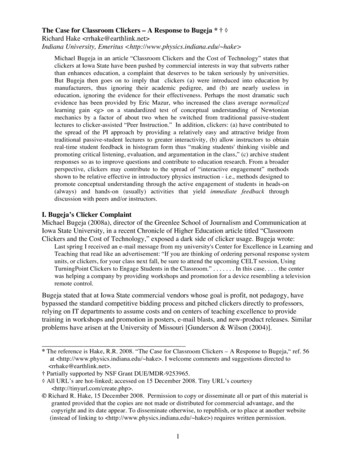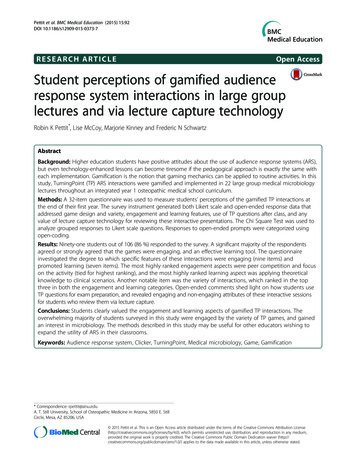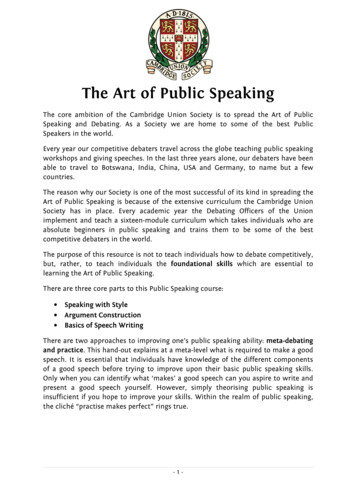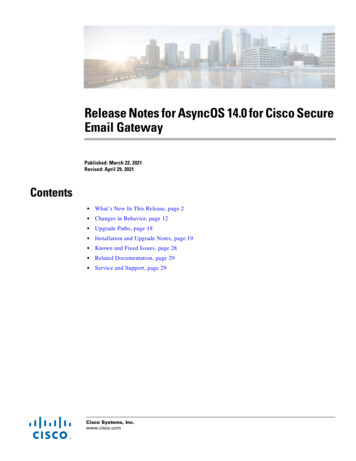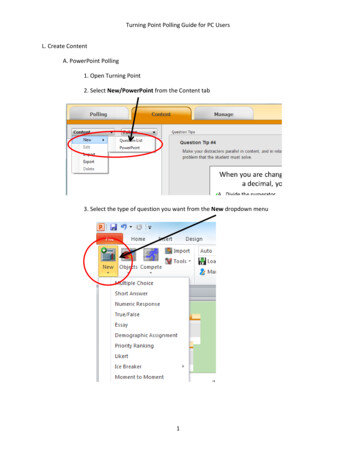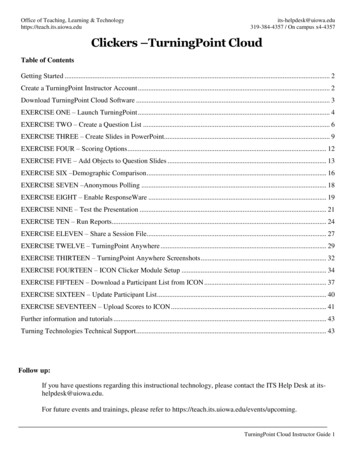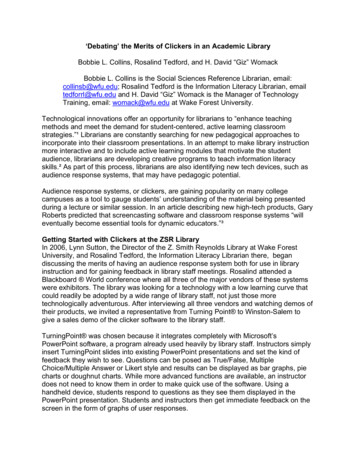
Transcription
‘Debating’ the Merits of Clickers in an Academic LibraryBobbie L. Collins, Rosalind Tedford, and H. David “Giz” WomackBobbie L. Collins is the Social Sciences Reference Librarian, email:collinsb@wfu.edu; Rosalind Tedford is the Information Literacy Librarian, emailtedforrl@wfu.edu and H. David “Giz” Womack is the Manager of TechnologyTraining, email: womack@wfu.edu at Wake Forest University.Technological innovations offer an opportunity for librarians to “enhance teachingmethods and meet the demand for student-centered, active learning classroomstrategies.”¹ Librarians are constantly searching for new pedagogical approaches toincorporate into their classroom presentations. In an attempt to make library instructionmore interactive and to include active learning modules that motivate the studentaudience, librarians are developing creative programs to teach information literacyskills.² As part of this process, librarians are also identifying new tech devices, such asaudience response systems, that may have pedagogic potential.Audience response systems, or clickers, are gaining popularity on many collegecampuses as a tool to gauge students’ understanding of the material being presentedduring a lecture or similar session. In an article describing new high-tech products, GaryRoberts predicted that screencasting software and classroom response systems “willeventually become essential tools for dynamic educators.”³Getting Started with Clickers at the ZSR LibraryIn 2006, Lynn Sutton, the Director of the Z. Smith Reynolds Library at Wake ForestUniversity, and Rosalind Tedford, the Information Literacy Librarian there, begandiscussing the merits of having an audience response system both for use in libraryinstruction and for gaining feedback in library staff meetings. Rosalind attended aBlackboard World conference where all three of the major vendors of these systemswere exhibitors. The library was looking for a technology with a low learning curve thatcould readily be adopted by a wide range of library staff, not just those moretechnologically adventurous. After interviewing all three vendors and watching demos oftheir products, we invited a representative from Turning Point to Winston-Salem togive a sales demo of the clicker software to the library staff.TurningPoint was chosen because it integrates completely with Microsoft’sPowerPoint software, a program already used heavily by library staff. Instructors simplyinsert TurningPoint slides into existing PowerPoint presentations and set the kind offeedback they wish to see. Questions can be posed as True/False, MultipleChoice/Multiple Answer or Likert style and results can be displayed as bar graphs, piecharts or doughnut charts. While more advanced functions are available, an instructordoes not need to know them in order to make quick use of the software. Using ahandheld device, students respond to questions as they see them displayed in thePowerPoint presentation. Students and instructors then get immediate feedback on thescreen in the form of graphs of user responses.
After watching the demonstration, library instructional staff were impressed withTurningPoint . The idea of using clickers in the library’s instructional program appearedpromising to most of the staff, but some were concerned about the amount ofpreparation required to implement this technology into existing library instructionalclasses. In deciding whether to invest time and money in clicker technology, staffpondered other questions: What would be the benefits of using the clickers? Wouldclickers eat up precious class time? And more importantly, how would students respondto this technology? Would it provide reliable and comprehensive feedback for bothinstructors and students?After considering the pros and cons of the clicker technology, the Information LiteracyLibrarian recommended purchasing 30 clickers and one receiver. The clickers weretested in two sections of the library’s for-credit Information Literacy class (LIB100) in theSpring of 2007. The students loved them and the clickers were such a popular itemamong library staff for a variety of purposes that in the Summer of 2007 an additional 30clickers and two receivers were purchased for library use. This article will discuss thelogistics of our implementation and discuss the ways we use clickers at Wake Forest.Along the way will we will look at successes, failures, and lessons learned and providetips for other libraries interested in this interactive technology.Training and Support for the ClickersDuring the summer of 2007, once the decision was made to use the clickers across thelibrary, several classes were given to show staff how to use the software withPowerPoint. The software was loaded on each person's machine before class time, sothat the class could be focused on using the software. For people who were not able toattend the classes, one-on-one help was given by the Information Literacy Librarian andGiz Womack, the Manger of Technology Training, on an as-needed basis. Although thesoftware is easy to install and use, not unexpectedly some glitches were encountered,especially in synchronizing receivers and computers. Those glitches were worked outeventually, however, and technical support for the clickers has been minimal. Additionalclasses in using the clickers will be taught again in the summer of 2008 for new staffmembers and those who use the software infrequently.Managing the ClickersEarly on it became apparent that a booking system was needed to manage the clickers.With several sections of the LIB 100 credit course and other library instruction classesbeing offered throughout the day, a central location for picking up and dropping off theclickers was essential. The 60 clickers were split into three sets, each with its owncarrying case, 20 clickers, one receiver, and several replacement batteries. We use aMicrosoft Outlook resource calendar to book the clickers. To reserve the clickers for aclass or meeting, a staff person checks an online calendar to make sure that a set ofclickers is available on the date(s) needed and then requests a reservation from the ILLibrarian or the Manager of Technology Training. If the class size is more than 20students, the instructor can book two sets of clickers. Along with figuring out a bookingsystem, the IL Librarian had to determine a safe and accessible location for housing the
clickers. Presently, the IL Librarian’s office houses the clickers and so far the bookingsystem is working.Putting the Clickers into Action with LIB 100 StudentsBecause we knew that students like using clickers “for immediate feedback, knowledgechecking, in-class surveys, group work, and other engaging activities,”4 we immediatelylooked for places to incorporate them into our instructional program.At the ZSR Library we teach a for-credit elective class for undergraduates and we arealways in the market for ways to make that class engaging and interactive for thestudents and instructors alike. The clickers seemed like a perfect opportunity for us todo this. In January and February of 2007 the Information Literacy Instructor took a fewof the PowerPoint presentations that were used by many instructors and addedTurningPoint ‘clicker’ slides to them. Then, she and our Technology Training Specialistused the clicker presentations in the two sections of LIB100 that they taught in the lateSpring. The course evaluation given at the end of the class included a question abouthow the students felt about the clickers. Their responses were almost universallypositive: I think the electronic polling tools were instrumental in creating participation in theclass structure.I liked the clickers, it’s a good way of letting students voice their opinions quickly.I really enjoyed the use of clickers in the class. While probably not necessary, Ido feel like they improved my overall classroom experience AND my ability toparticipate regularly.the clickers were fun. I think the class responded more than they would havewithout the clickers.I really enjoyed the clickers, I thought they were a clever idea and a good way tokeep class interesting with student participation.The clickers were great---they encouraged student participation, they were fun,they were exciting.The clickers were a great idea though they didn't always work. I found them fun. Ialso feel as though they offered a way for all students to contribute to classdiscussions while eliminating that fear of raising your hand and feeling singledout. I wish all professors used this.In addition to these advocates, however, there were a few students who were not asenthusiastic. Statements like, "I thought the clickers were okay but I feel like everythingthese days is a poll. Everybody wants to know what everybody else thinks, so it getssort of annoying but they weren't too bad," and "The clickers were a gimmick, they didnext to nothing and just took up time," made us aware of the fact that not all studentswill respond positively to this technology in the classroom.Bolstered by the positive feedback, the Information Literacy Librarian took the summerto rework most of the class PowerPoint presentations to include clicker slides. Theywere then presented to the LIB100 instructors and made available to them over the
campus network. Instructors could copy the presentations to their hard drives and alterthem as needed. The TurningPoint training empowered instructors to create their ownpresentations to cover the material in the way they saw fit. The Information LiteracyLibrarian and the Technology Training Manager were available to the instructors to helptroubleshoot problems before, during, or after their classes.Overall, the clickers have not changed what we teach in our LIB100 classes as much asthey have changed how we teach. The students are more engaged in the content whenthey get immediate feedback, and we have found that better classroom discussionsensue. The clickers are generally not used for graded assignments, but rather to pointout to students what they do and do not already know about doing research and to getthem to use searching skills on the fly to answer questions. When they all answer aquestion incorrectly, they tend to pay more attention when you are providing theanswer. In future semesters we hope to harness some of the advanced features of theclickers to do more competitive activities where teams can compete on questions andwhere we can track individual answers. But for now the students seem to like being ableto respond in class with this technology and certainly seem to think it makes the classmore interesting.Debating the Merits of Clickers with High School StudentsAfter watching a demo of TurningPoint , it became clear to the lead instructor thatclickers could be used to check for student comprehension in the Wake ForestUniversity summer debate workshops for high school students. As part of the learningexperience, debaters participate in a hands-on library session which includes anorientation to the library’s online catalog, databases, and other electronic resources. Inthe summer of 2007, two groups of debaters (total of 37 students) came to the library’scomputer lab for a two-hour session on researching their debate topic. At the beginningof class, the students were instructed on using the clickers and were given five practicequestions: Have you ever used a clicker or an electronic classroom response system?If yes, where did you use a clicker?What part of the country are you from?When you return to your school in the fall, will you be a freshman, sophomore,junior, senior, or college bound?Have you attended a WFU debate workshop?The idea of using practice questions was to help calm fears. Some of the debaters wereaway from home for the first time. They were in a new learning environment andprobably felt somewhat overwhelmed. Using practice clicker questions at the beginningof class helped the students feel more comfortable and, as one debater observed, the“ice-breaker” questions were fun and interesting!During the instructional session, students used clickers to respond to questions.Students were asked about LC Subject Headings and call numbers, locations of specifictitles that are located in the stacks or online, and search strategies such as the use of
Boolean operators and truncation. In the majority of cases, the students did well on thequestions, but most questions had a few incorrect responses. The benefit of asking forthe answers through clicker responses is that the instructor gets immediate feedback onproblem areas and can revisit content in response to incorrect answers.How did the debaters react toward the clickers? Data about student perceptions of theclickers were collected from a brief evaluation form which 36 debaters turned in at theend of the workshop. A majority of the debaters (86%) agreed or strongly agreed thatthey enjoyed using the clickers to respond to questions. Approximately 44% of thedebaters indicated that using the clickers to respond to questions allowed them to betterunderstand the material, while 39% were undecided.The debaters were also asked to list some advantages and disadvantages of using theclickers in the classroom. Interestingly, debaters' comments were very similar to thoseof the LIB 100 students. For instance, some of the advantages that the debatersmentioned were: the anonymous feature; fun; quick response time; everyoneparticipates; and the clickers create a more interactive environment. One debatercommented that “it provides a quick glance of the classes’ knowledge to compare toyourself.” Disadvantages included: having to press several times to ensure yourresponse is counted; hard to press; easily broken or stolen. Several students remarkedthat the clickers discourage note taking. One student noted: “Sometimes I wouldaccidentally press [the] wrong button.”One reason why the debaters were very enthusiastic about the clickers is that these“students of the twenty-first century have grown up using computer games for learningand entertainment.”5 And as one debater mentioned, the clickers “make the instructionalsession less boring. Now the lesson is an interactive game.” When asked if the Z. SmithReynolds Library should continue to use clickers in library instructional sessions, thedebaters overwhelmingly answered in the affirmative.Soliciting Feedback from StaffOne of the driving forces behind investigating the clickers was our director’s desire toget staff feedback on various topics. In the Fall of 2006 and the Spring of 2007 the ZSRLibrary was in the midst of a strategic planning process that was part of the largeruniversity’s strategic planning taking place under our new president. The planningcommittee (Blue Sky) solicited input from library staff on our building, our services, ourcollections, and many other topics. The Blue Sky committee then developed lists ofideas and suggestions in each of these areas.In order to get an idea of how our staff would prioritize these ideas and suggestions, wehad a library-wide staff meeting where the clickers were used. Our director very muchwanted to hear equally from every staff member and since the clickers are anonymousand do not discriminate against the quieter people on the staff, they seemed the perfectoption for feedback.
Staff were presented with various ideas (e.g. building an off-site storage facility) andwere asked how important they thought they were. Then the results of these questionswere used by our Director as she formulated the final strategic plan. There were someexpected outcomes and some surprises, but our director was pleased to have equalfeedback from our entire staff on the issues at hand as she wrote the final document.An added benefit of this process was that the entire library staff got to see the clickers inaction and soon other committees and groups of staff were finding uses for them.Taking the Clickers on the RoadIn addition to being an effective tool in the classroom, clickers can also offer presentersan excellent opportunity to learn about their audience and to adjust a presentationaccordingly. When speaking at a conference or at another institution, the presenter isoften unsure what the audience knows about the topic and where it stands on issuessurrounding the topic. Beginning a presentation with clicker questions about the topiccan give the speaker insight into the audience and an opportunity to adjust thepresentation to better meet its needs.An example of this approach is the Wake Forest University / Georgia Institute ofTechnology joint presentation on gaming in academic libraries at the first ALA GamingSymposium in July of 2007. This was the first conference of its type and as such, thepresenters knew even less than usual about the content the audience expected fromthis presentation. To solve that, we asked four questions to establish the demographicsof the group and learn more about needs.Through four clicker questions in three minutes, it was determined that 86% of theparticipants were from academic libraries, 80% had not yet hosted a gaming event inthe library, 60% were considering hosting such an event, and 40% of those would hostsuch an event as a marketing tool for their libraries. As a result of these questions wewere able to tailor the presentation on the spot to focus on the logistics of hosting agame night rather than focusing on why libraries would host game nights. This was aneasy transition to make that gave our audience more value.Another example of using clickers to enhance a presentation also involves gaming inacademic libraries. When presenting “How to Get Game: Conducting Gaming Events inan Academic Library” at East Carolina University, the Manager of Technology Trainingused clickers to determine how many members of the audience were gamers orinterested in video games. Only 24% identified themselves as gamers and 49%responded, “What’s a Gamer?” Fifty-eight percent said they were there to learn aboutgaming and how to host an event. Realizing there was audience of people new togaming but interested in the topic, the presenters could adjust accordingly, attempting toinclude information that would generate interest in gaming among the other 38%.For clickers to be effective, speakers must be willing to adapt their presentations quicklyto meet the needs of the audience. Additionally, they must be adept at troubleshootingpotential software or hardware issues with the clickers in order to ensure a smooth
presentation. If they are willing to make this extra effort, clickers can enhance apresentation and offer more value to the audience.Committing to ClickersAs with the use of any new educational device, instructor feedback regarding theperceived impact of the new technology on student learning and retention is important.Before instructors commit to incorporating novel instructional approaches into theirclassrooms, they must see the potential payoffs in order to decide if the new tech toolwill have an impact on student performance. An important part of the teaching processinvolves designing and developing instructional content; if instructors perceive that anew educational device will disrupt or hinder their efforts, they may abandon the idea ofexperimenting with a teaching tool. As clicker enthusiasts know, it takes time to developgood clicker questions and organize effective PowerPoint presentations.Another clicker issue to consider is class time. If an instructor includes four or fiveclicker questions, it “will probably take an additional 10 minutes of class time, at aminimum.”6 Instructors who teach 50-minute classes may find that they cannot cover asmuch material when using the clickers. During the live presentation, these instructorsmay find they are tweaking their lectures and at the same time inadvertently developinga new set of instructional strategies to improve and support clicker technology.Our clicker experience has demonstrated that when there are fewer students, clickerresponse time is very fast. During the summer, there were 11 debaters in the first classand 26 in the second class. In the first class, the response time was great. However,with more students in the second class the response time was a little slower. In fact,several debaters in the second class noted that the lesson had to be delayed so thateveryone could respond. Instructors will need to decide how long to wait for students toanswer the questions, as slow response time will impact the timing and delivery ofinformation in the instructional session.Given that some instructors have encountered a few problems in using clickers, most ofthe LIB 100 instructors continue to use the clickers and so far the novelty has not wornoff. Instructors are finding that the clickers help the students to stay focused on thelecture. In addition, librarians who teach information literacy classes using clickers havea better understanding of areas where students are having difficulty grasping aparticular concept or skill. If 80% of the students miss a question on Boolean operators,the librarian can go back and cover the concept again. Another tactic that has provensuccessful is to give students a question or two at the beginning of the class about thematerial about to be covered. In almost all cases, a large percentage of students willanswer the questions incorrectly, thus perhaps making them pay more attention to thecontent of the class. And if all of the students happen to answer them correctly, thenclass content can be altered to cover new topics.Our least successful use of clickers occurred in the Wake Forest University freshmanorientation program, “Technology@WFU”. In this program, students receive informationabout computing at Wake Forest. Clicker questions were incorporated into the
PowerPoint program after each section of content to see if the students got themessage we were conveying. Sixty clickers were passed out among the 550 students ineach of the two sections of “Technology@WFU”. Each student with a clicker answeredone question and passed the clicker on to another student who answered the nextquestion. This effort did not engage the students as anticipated, perhaps because of alack of clickers for all students.Clicking PointersThe integration of the clickers into a library session can be an exciting experience forboth instructors and students. Here a few points to keep in mind:1. Do your homework. Be sure to understand who in your organization will be usingthe clickers and how comfortable they are with technology. Then investigate thevarious vendors and find the best match for you. From a user perspective,clickers work pretty much the same from vendor to vendor. The major differenceslie in the back-end interfaces; thus the highest learning curve is for the peoplecreating the clicker presentations. Clicker systems provide various levels offunctionality and with that functionality come more complicated processes on theinstructors’ end. Be sure instructors attend the demos and have input into thedecision.2. Build on success. Examine what you have traditionally done in the classroom.What worked? Don’t be afraid to experiment with new approaches. Innovativeinstruction sometimes requires thinking outside of one’s comfort zone.3. Create a plan of action and start early. Redesigning and developing newinstructional content takes time. Coming up with good questions to use andorganizing the PowerPoint slides are crucial for an effective presentation. Onesuccessful strategy we have employed is the sharing of PPT presentations withclicker slides among instructors. This gives instructors the ability to focus on thecontent and not the creation of new clicker slides. It is also critical to allowinstructors time to practice their PowerPoint presentations and to receivefeedback from other librarians if they are uncomfortable using clickers for the firsttime in a real classroom setting.4. Seek tech support along the way. If you are not tech savvy, team up with techpeople. Have someone come at the beginning of class to make sure that all ofthe equipment is working. Also, before you launch into your presentation, do asimple test to ensure that both the receiver and the clickers are working. Oursystem requires running the “restart wizard” each time a different receiver isused. Taking time to check out potential tech problems will help with point five.5. Calm fears. This point impacts both librarians and students. Naturally, instructorsare going to be nervous during the first presentation with new technology. Keep apositive attitude and project this to your audience.6. Consider using practice clicker questions at the beginning of class or a meeting.It is a great way to grab an audience’s attention and involve them in theupcoming presentation while ensuring your clickers and software are working.
ConclusionBased on our experiences, the clickers are definitely a hit with our staff and ourstudents. The enthusiastic assessment by WFU and high school students suggests thatclickers can be a valuable teaching tool. As new technologies impact higher education,librarians must seize the opportunity to investigate and evaluate the most appropriateones for delivery of information in order to enhance the teaching and learning process.At ZSR we continue to experiment with advanced functionality such as assigningclickers to individuals for assessment purposes and with using them with groups forcompetitions. We would also like to include clickers in one-shot library instructionsessions. A few well-placed questions during these sessions may make students moreattentive and engaged in the content. We continue to look for ways we can incorporatethe clickers into staff meetings, committee work, and other in-house projects across thelibrary. All in all, we have been extremely pleased with the clickers and hope to continueto find new and innovative ways to incorporate them into our services.References¹Christina Hoffman and Susan Goodwin, “A Clicker for your Thoughts: Technology forActive Learning,” New Library World 107, no. 9/10 (2006): 422-433.²Wenxian Zhang, “Building Partnerships in Liberal Arts Education: Library TeamTeaching,” Reference Services Review 29, no. 2 (2001): 141-149.³Gary Roberts, “Instructional Technology That’s Hip High-Tech,” Computers in Libraries25 (November/December 2005): 26-28.4Jim Tweeten et al., “Successful Clicker Standardization,” EDUCAUSE Quarterly 30,no.4 DUCAUSE Quarterly/SuccessfulClickerStandard/45543 (February 11, 2008).5Margie Martyn, “Clickers in the Classroom: An Active Learning Approach,”EDUCAUSE Quarterly 30, no.2 (2007) 71-74.http://connect.educause.edu/Library/EDUCAUSE Quarterly/ClickersintheClassroomAnA/40032 (February 11, 2008).6Tweeten et al., “Successful Clicker Standardization.” 66.
High school debaters give the clickers a workout during a hands-on instructional session in the library’scomputer lab.
Clickers are becoming an important pedagogical tool to promote active learning in instructional sessionsat ZSR.
Here is an example of a multiple choice question and the results you get. Questions can be True/False,Multiple Choice, Likert, Multiple Answer or even Analogies or Word Scrambles as Ice Breakers.
Audience response systems, or clickers, are gaining popularity on many college campuses as a tool to gauge students' understanding of the material being presented during a lecture or similar session. In an article describing new high-tech products, Gary Roberts predicted that screencasting software and classroom response systems "will


